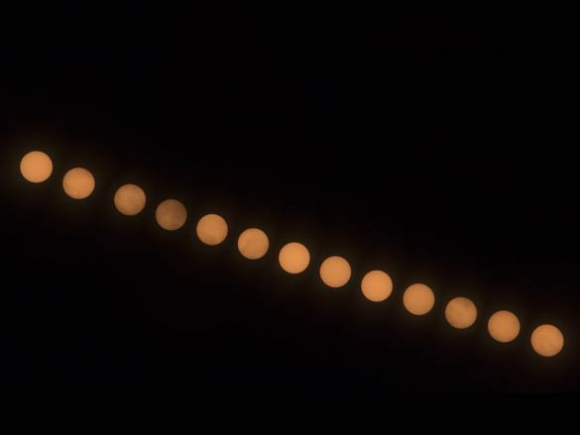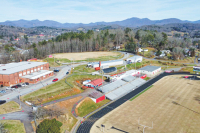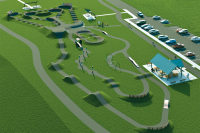Prepare to shoot: Eclipse photography takes research, preparation

It’s safe to say that a good solar eclipse photo requires a bit more preparation than your average snapshot.
Perhaps most obviously, there’s the need for a solar filter to prevent camera damage — a piece of equipment that few photographers have likely had occasion to order before the run-up to the Great American Eclipse of 2017. Then there’s the challenge of finding the right exposure to capture this once-in-a-lifetime event, and the pressure of knowing that you’ve got only one chance — and that the moment is passing swiftly by.
Roger Bacon, a retired Western Carolina University professor and avid photographer, has been working for quite a while to maximize his chance of capturing the perfect image, and he’s enjoyed the process.
“If we have a day like today, the eclipse is going to be a little bit anticlimactic, but for me the preparation has been so much fun,” Bacon said during a presentation he gave on a rainy day in Sylva.
Preparation is perhaps the first rule to getting quality eclipse images. Make sure you know where you’ll be watching, make sure you have all the equipment you need, and practice photographing the afternoon sun leading up to the event to get your camera settings locked in.
The eclipse will include three main opportunities to capture a striking image. During a presentation he gave at the Jackson County Public Library Thursday, Aug. 10, Bacon gave his tips for each.
Related Items
Partial eclipse
The partial eclipse occurs as the moon partially covers the sun but does not completely block it. During this time, it’s essential that any camera lens — including lenses on smartphones — be covered with a special solar filter to prevent camera damage.
• Use a telephoto lens of 500 to1,000 millimeters to get a close-up view.
• Mount the camera on a sturdy, tall tripod, and use a remote shutter release button if possible to avoid shaking the camera while taking images.
• Set shutter speed and aperture manually, as auto settings will yield a washed-out image of the sun.
• Set the camera to bracket each shot so that every press of the shutter button yields three photos taken with multiple exposure settings.
• Keep solar glasses handy. Don’t wear them while looking at the camera screen, but always wear them when looking at the sun.
• Using the screen to frame your shot is safer than using the viewfinder.
• Cover the back of the camera with a blanket so you can see the screen better.
• If using tape to attach filters to the camera, use painters tape to avoid sticky residue.
Time lapse
Some of the most striking eclipse images show a composite time lapse of the partially eclipsed sun making its way across the sky. Producing these images requires digitally combining individual photos afterward.
• Use a wider-angle lens — 75 to 125 millimeters — in order to capture multiple images of the sun making its way across the sky.
• Leave at least three minutes between images.
• Set shutter speed and aperture manually.
• Be careful not to move the camera in between shots. A remote shutter release button is handy.
• Be sure to use a solar filter. Same safety precautions apply as with other partial eclipse shots.
Totality
At totality, the sun’s pearly corona will be visible and a tempting catch for photographers.
• Remove solar filter quickly when totality begins.
• Use a telephoto lens — 500-1,000mm — to get as close to the sun as possible.
• Switch the camera from manual to automatic.
• Totality will be over quickly. Take lots of pictures in hopes of ending up with a few good ones.
• Set the camera to bracket all shots.
• As soon as any bright light is visible, get your eye out of the viewfinder. Replace the solar filter before taking any more shots.
In the camera bag
Being prepared is the key to taking quality eclipse images. The much-anticipated event will come and go surprisingly quickly, so spend some time thinking about what you’ll need and gathering those items in preparation.
• A telephoto lens of 500 to 1,000 millimeters to take close-up images of the sun.
• A wider-angle lens to try for time-lapse photos and to take photos of the landscape as a whole.
• Solar filters for each lens to be used. Filters can be purchased premade or made from special solar filter paper. Scratched filters are not safe to use.
• A sturdy tripod.
• A blanket to cover the back of the camera, making it easier to see the screen.
• A remote shutter release button.
• Double-check that the battery is charged and the memory card has as much space as possible.
• Lens cleaner and a microfiber cloth.
Learn more
When it comes to solar eclipses, there’s a lot to learn — but also a lot available for those who want to know.
• Retired NASA astrophysicist and photographer Fred Espenak lays out detailed information about eclipse photography, as well as other aspects of the phenomenon, at www.mreclipse.com. Espenak also maintains the site www.eclipsewise.com.
• For forecasts of cloud cover on eclipse day, visit www.cleardarksky.com. The site provides detailed cloud cover information for sites along the eclipse path for conditions up to two days out.
• Master astrophotographer Jerry Lodriguss gives valuable tips and information at www.astropix.com.









